The Kaveri Refresh 'Godavari' Review: Testing AMD's A10-7870K
by Ian Cutress on June 1, 2015 11:59 AM ESTProfessional Performance: Linux
Built around several freely available benchmarks for Linux, Linux-Bench is a project spearheaded by Patrick at ServeTheHome to streamline about a dozen of these tests in a single neat package run via a set of three commands using an Ubuntu 11.04 LiveCD. These tests include fluid dynamics used by NASA, ray-tracing, OpenSSL, molecular modeling, and a scalable data structure server for web deployments. We run Linux-Bench and have chosen to report a select few of the tests that rely on CPU and DRAM speed.
C-Ray: link
C-Ray is a simple ray-tracing program that focuses almost exclusively on processor performance rather than DRAM access. The test in Linux-Bench renders a heavy complex scene offering a large scalable scenario.
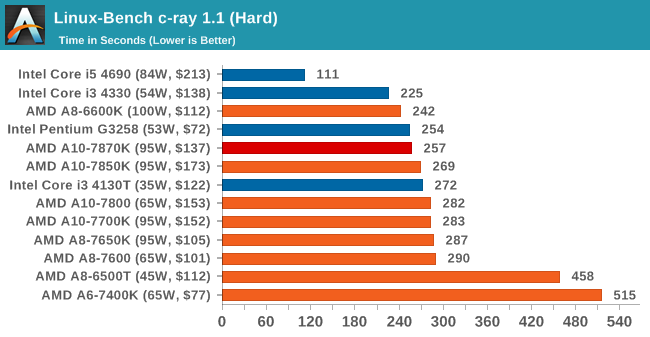
NAMD, Scalable Molecular Dynamics: link
Developed by the Theoretical and Computational Biophysics Group at the University of Illinois at Urbana-Champaign, NAMD is a set of parallel molecular dynamics codes for extreme parallelization up to and beyond 200,000 cores. The reference paper detailing NAMD has over 4000 citations, and our testing runs a small simulation where the calculation steps per unit time is the output vector.
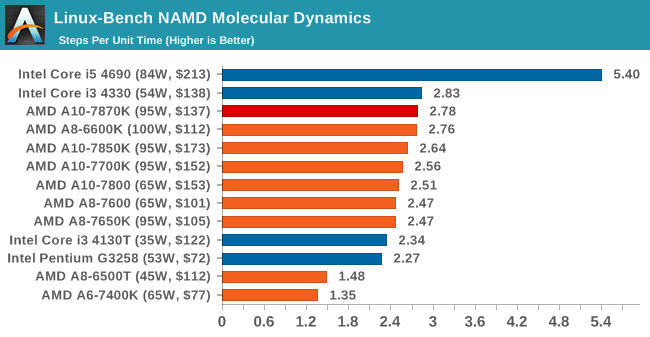
NPB, Fluid Dynamics: link
Aside from LINPACK, there are many other ways to benchmark supercomputers in terms of how effective they are for various types of mathematical processes. The NAS Parallel Benchmarks (NPB) are a set of small programs originally designed for NASA to test their supercomputers in terms of fluid dynamics simulations, useful for airflow reactions and design.
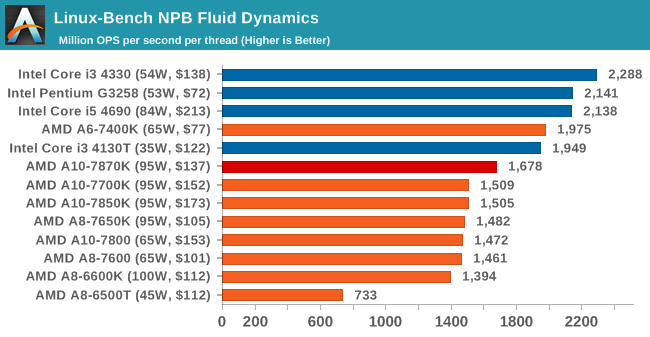
Redis: link
Many of the online applications rely on key-value caches and data structure servers to operate. Redis is an open-source, scalable web technology with a strong developer base, but also relies heavily on memory bandwidth as well as CPU performance.
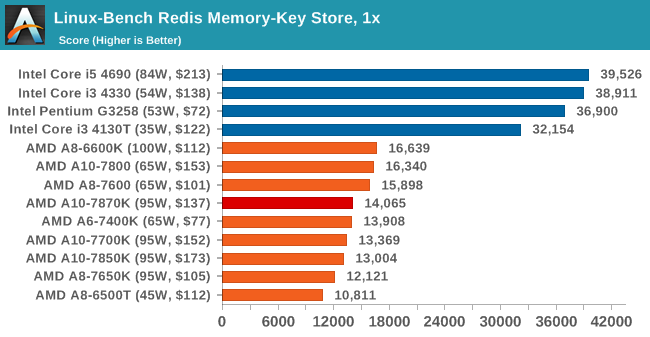

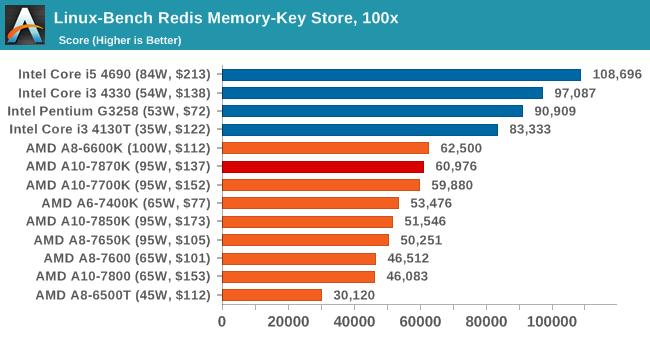










140 Comments
View All Comments
barleyguy - Monday, June 1, 2015 - link
I have an HTPC in a tiny case (mini ITX and only a couple inches tall), powered by an A8-7600. For the price, form factor, and versatility (allows midrange gaming), I feel it was a really good choice.That said, I'm a little bit disappointed in this release, not so much because it's beaten in CPU benchmarks by a more expensive Intel that requires a larger case for a decent GPU, but because the 7870 isn't much faster than the A8-7600. It's more expensive and uses twice the power. (The A8-7600 has a 45W mode. It idles at less than 20 watts and peaks at about 60 watts for the whole system with an SSD.)
Like others have said, I would love an FM2+ Carrizo. Hopefully that would bring noticeably higher performance at the 45W level.
TallestJon96 - Monday, June 1, 2015 - link
This isn't for me, but it seems like these APUs are growing better more quickly than any other CPU or GPU section. Power consumption is a bit high, but if you don't have a dedicated graphics card it definitely manageable.My biggest concern is the slow ram for graphics. This is tested on 2133 ram but the target audience for this will have 1333 or 1600... I'd like to know how much performance changes then.
But it's pretty impressive for the price, and it should suit people who do web browsing, Netflix and light gaming extremely well.
barleyguy - Monday, June 1, 2015 - link
I'm running 2133 on my A8-7600 HTPC. It was only about $10 extra for 4 GB. If the target audience is running 1333 or 1600, it's because they didn't know any better. IMO.nikaldro - Monday, June 1, 2015 - link
If that 2133Mhz RAM has horrible timings, you didn't solve much...barleyguy - Monday, June 1, 2015 - link
It's CAS latency 9, 9-10-9-27, Corsair XMS. Nothing wrong with it.Lolimaster - Tuesday, June 2, 2015 - link
Probably the best all around memory timming for an APU unless you find a really cheap 2600 cl11.movax2 - Monday, June 1, 2015 - link
I made a few calculations in Excel.Let's see.
CPU's performance (Windows only: Office-Web + Pro) on average7870K is 0.11% faster than 7850K! Yes, less than 1%.
GPU performance: +1.2%
One word:
disappointment.
Cryio - Monday, June 1, 2015 - link
How did you make the calculations? Do you have on hand a 7870K and a 7850K? Not to mention 8 GBs of DDR3 2400 ram in dual channel?DrMrLordX - Monday, June 1, 2015 - link
Many recent UEFI versions showing "support for Godavari/Kaveri refresh" overvolt the hell out of these chips. It's no wonder they were showing 117W draw. Some of these UEFI revisions are pushing 1.45v OR MORE!Older Kaveri chips (KA-V1) can do 3.9 ghz with only 1.2v on average. Newer ones (GV-A1; 7870k, 7670k, OEM 8500B) should be able to do it with less. There is NO WAY anyone should be pushing this kind of voltage. Some reviews have shown throttling to 1.6 GHz from the board/cpu being overloaded by sheer heat/power draw from these insane voltages (cpu-world, which updated their results with a new UEFI revision that backed voltage off to "only" 1.45v).
There is obviously more work that needs to be done to bring voltage numbers down for stock and the various turbo states supported by this chip, as well as other Kaveri variants. In the meantime, anyone buying this chip should expect it to turn in better results than the 7850k AND do it with less voltage at the same clockspeed (or the same voltage for slightly higher clocks). Just tweak the voltages manually in the UEFI and things should work great.
Lolimaster - Tuesday, June 2, 2015 - link
Exactly, the extra voltage allowed by AMD goes mainly to the gpu part, 20% clocks.